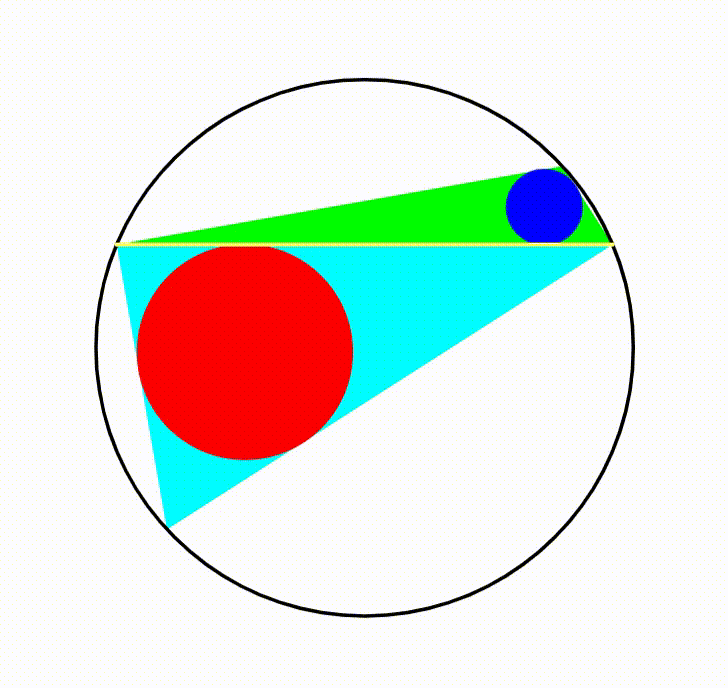Dynamic Geometry: P128
 The diagram shows a black circle. A horizontal black chord is drawn creating two circular segments, their respective heights are
and
. In each circular segment, we inscribe a triangle. In both triangles we draw the incircle. The apex of the triangles need to be diametrically opposed. When the ratio of the blue incircle's radius to the radius of the red incircle is equal to
, the ratio of the upper triangle's area to the area of the lower triangle can be expressed as
. Find
.
The diagram shows a black circle. A horizontal black chord is drawn creating two circular segments, their respective heights are
and
. In each circular segment, we inscribe a triangle. In both triangles we draw the incircle. The apex of the triangles need to be diametrically opposed. When the ratio of the blue incircle's radius to the radius of the red incircle is equal to
, the ratio of the upper triangle's area to the area of the lower triangle can be expressed as
. Find
.
The answer is 323.
This section requires Javascript.
You are seeing this because something didn't load right. We suggest you, (a) try
refreshing the page, (b) enabling javascript if it is disabled on your browser and,
finally, (c)
loading the
non-javascript version of this page
. We're sorry about the hassle.
From the compiled calculations in Dynamic Geometry: P96 Series , we know that the radius of the large circle is 6 . 5 , the dividing chord A B = 1 2 , ∠ A C B = π − tan − 1 5 1 2 , and ∠ A C ′ B = tan − 1 5 1 2 .
Let the center of the large circle O be the origin of the x y -plane. Then C = ( 6 . 5 cos θ , 6 . 5 sin θ ) and C ′ = ( − 6 . 5 cos θ , − 6 . 5 sin θ ) , where θ is the angle C C ′ makes with the x -axis. The inradius of △ A B C is r = s A , where A and s are the area and semiperimeter or △ A B C respectively, then:
r = C A + B C + A B A B ⋅ C D where C D is the height of △ A B C = ( 6 . 5 cos θ + 6 ) 2 + ( 6 . 5 sin θ − 2 . 5 ) 2 + ( 6 . 5 cos θ − 6 ) 2 + ( 6 . 5 sin θ − 2 . 5 ) 2 + 1 2 1 2 ( 6 . 5 sin θ − 2 . 5 ) = − 3 2 . 5 sin θ + 7 8 cos θ + 8 4 . 5 + − 3 2 . 5 sin θ − 7 8 cos θ + 8 4 . 5 + 1 2 7 8 sin θ − 3 0
Similarly for △ A B C ′ :
r ′ = 3 2 . 5 sin θ + 7 8 cos θ + 8 4 . 5 + 3 2 . 5 sin θ − 7 8 cos θ + 8 4 . 5 + 1 2 7 8 sin θ + 3 0
When r ′ r = 1 6 9 ,
⟹ ( 7 8 sin θ + 3 0 ) ( − 3 2 . 5 sin θ + 7 8 cos θ + 8 4 . 5 + − 3 2 . 5 sin θ − 7 8 cos θ + 8 4 . 5 + 1 2 ) ( 7 8 sin θ − 3 0 ) ( 3 2 . 5 sin θ + 7 8 cos θ + 8 4 . 5 + 3 2 . 5 sin θ − 7 8 cos θ + 8 4 . 5 + 1 2 ) = 1 6 9
Solving the equation above, we have θ = sin − 1 3 2 5 3 2 3 . Since the upper and lower triangles have the same base A B , their area is proportional to their height. Then we have:
A ′ A = h ′ h = 6 . 5 sin θ + 2 . 5 6 . 5 sin θ − 2 . 5 = 3 2 3 + 1 2 5 3 2 3 − 1 2 5 = 4 4 8 1 9 8 = 2 2 4 9 9
Therefore p + q = 9 9 + 2 2 4 = 3 2 3 .